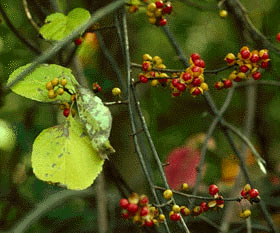Celastrus
Celastrus, commonly known as bittersweet or staff vine, is a genus of shrubs and woody vines in the family Celastraceae. This genus is native to temperate and tropical regions of the world, with a majority of the species found in East Asia and North America. Celastrus is notable for its attractive berries, which change color as they mature, and its use in traditional medicine across various cultures. The plants are also valued for their ornamental qualities and have been used in landscape gardening.
Description[edit | edit source]
Celastrus species are deciduous or evergreen shrubs or vines. They possess simple, alternate leaves and small, inconspicuous flowers that are greenish-white to yellow in color. The flowers are dioecious, meaning that male and female flowers are found on separate plants. The fruit of Celastrus is a capsule that opens to reveal seeds covered in a fleshy aril, which is typically bright orange or red, making them highly visible and attractive.
Distribution and Habitat[edit | edit source]
The genus Celastrus is widely distributed across the globe, from the temperate regions of North America and Europe to the tropical climates of Asia and Australia. These plants are adaptable and can be found in a variety of habitats, including forests, grasslands, and along riverbanks. They are particularly prevalent in mountainous regions and are capable of thriving in a range of soil types, though they prefer moist, well-drained soils.
Species[edit | edit source]
There are approximately 30-40 species within the genus Celastrus, including:
- Celastrus orbiculatus – Oriental bittersweet, native to East Asia, is considered invasive in some parts of North America.
- Celastrus scandens – American bittersweet, native to North America, is valued for its ornamental features.
- Celastrus paniculatus – Known as the black oil plant or intellect tree, native to India and Southeast Asia, is used in traditional medicine.
Uses[edit | edit source]
- Traditional Medicine ###
Celastrus has been used in traditional medicine for centuries, particularly Celastrus paniculatus, which is renowned for its nootropic properties. It is believed to enhance cognitive functions, memory, and learning. The seeds and oil extracted from the seeds are used in various traditional medicine systems to treat a range of ailments, including mental disorders, rheumatism, and skin diseases.
- Ornamental Use ###
Due to their attractive foliage, flowers, and colorful berries, several Celastrus species are used in ornamental horticulture. They are often planted as climbing vines to cover fences, trellises, and walls, adding visual interest to gardens and landscapes.
- Environmental Impact ###
While Celastrus species like Celastrus orbiculatus are valued for their ornamental qualities, they can become invasive outside their native range, outcompeting local flora and altering habitats. Efforts are made in some regions to control their spread and minimize ecological damage.
Conservation[edit | edit source]
The conservation status of Celastrus species varies widely. While some species are common and have adapted well to human activities, others are considered rare and face threats from habitat destruction and overharvesting. Conservation efforts are necessary to ensure the survival of vulnerable species within the genus.
Search WikiMD
Ad.Tired of being Overweight? Try W8MD's physician weight loss program.
Semaglutide (Ozempic / Wegovy and Tirzepatide (Mounjaro / Zepbound) available.
Advertise on WikiMD
|
WikiMD's Wellness Encyclopedia |
| Let Food Be Thy Medicine Medicine Thy Food - Hippocrates |
Translate this page: - East Asian
中文,
日本,
한국어,
South Asian
हिन्दी,
தமிழ்,
తెలుగు,
Urdu,
ಕನ್ನಡ,
Southeast Asian
Indonesian,
Vietnamese,
Thai,
မြန်မာဘာသာ,
বাংলা
European
español,
Deutsch,
français,
Greek,
português do Brasil,
polski,
română,
русский,
Nederlands,
norsk,
svenska,
suomi,
Italian
Middle Eastern & African
عربى,
Turkish,
Persian,
Hebrew,
Afrikaans,
isiZulu,
Kiswahili,
Other
Bulgarian,
Hungarian,
Czech,
Swedish,
മലയാളം,
मराठी,
ਪੰਜਾਬੀ,
ગુજરાતી,
Portuguese,
Ukrainian
Medical Disclaimer: WikiMD is not a substitute for professional medical advice. The information on WikiMD is provided as an information resource only, may be incorrect, outdated or misleading, and is not to be used or relied on for any diagnostic or treatment purposes. Please consult your health care provider before making any healthcare decisions or for guidance about a specific medical condition. WikiMD expressly disclaims responsibility, and shall have no liability, for any damages, loss, injury, or liability whatsoever suffered as a result of your reliance on the information contained in this site. By visiting this site you agree to the foregoing terms and conditions, which may from time to time be changed or supplemented by WikiMD. If you do not agree to the foregoing terms and conditions, you should not enter or use this site. See full disclaimer.
Credits:Most images are courtesy of Wikimedia commons, and templates, categories Wikipedia, licensed under CC BY SA or similar.
Contributors: Prab R. Tumpati, MD

